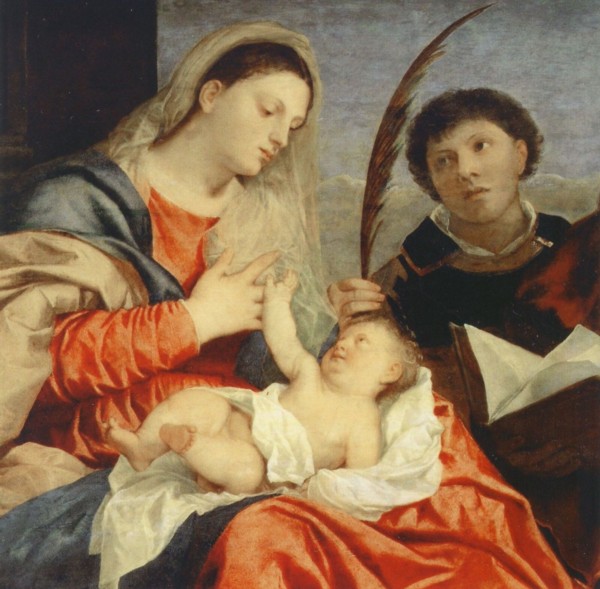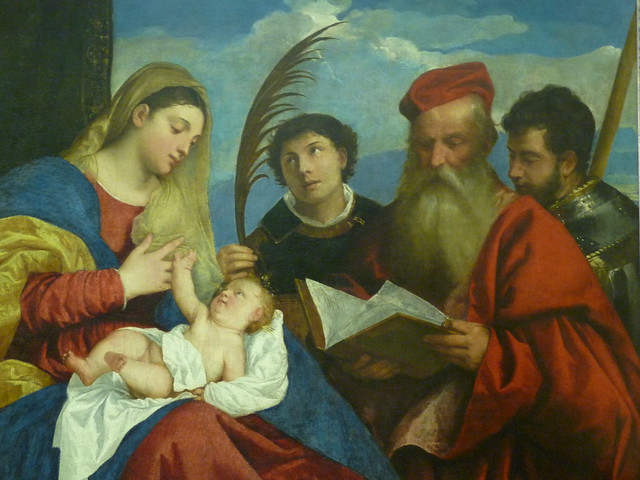

MUSIC FOR THE VESPERS OF THE VIRGIN MARY
When Claudio Monteverdi (1567-1643) published his famous Vespro
della beata Vergine in Venice in 1610, there was no doubt that he
had created a monument in sound, one that would astonish the listener
with its ingenious combination of styles and sumptuous orchestration at
the very least. Its roots, however, go back deep into the 16th century;
Monteverdi was actually continuing a tradition that had been launched
by none other than Adriaen Willaert (c. 1490-1562), with his Vespro
della Madonna, part of his I sacri e santi salmi (Venice,
1555). This tradition is the inspiration for this recording, in which
Capilla Flamenca has recreated a Venetian Vespers dedicated to the
Virgin Mary.
Vespers is one of the liturgical Hours or offices that are celebrated
at defined moments of the day. In accordance with its Latin etymology
(vespera meaning evening), Vespers were held between 5 and 6pm. In
common with the other liturgical Hours, Vespers followed a strict
formal pattern: the opening verse Deus in adiutorium was
followed by five psalms, a reading of a lesson or capitulum, a hymn, a Magnificat
with antiphon, prayers and the concluding Benedicamus Domino.
Such consistency in the liturgy had an important consequence for
composers, as they were then required to distance themselves from the
age-old Gregorian chants with their unison melodies. The
composers’ skills were applied to the integration of these fixed
requirements into a polyphonic frame and thus created the necessary
variety of texture for the listener. Willaert found and perfected this
balance in his compositions like no other composer of his time.
Five psalms, the Dixit Dominus (ps. 109), Laudate pueri
(ps. 112), Laetatus sum (ps. 121), Nisi Dominus (ps.
126) and Lauda Jerusalem (ps. 147) lie at the heart of Vespers
and therefore at the heart of this recording also. Thanks to Willaert,
Vespers settings became much larger in scale: Willaert integrated
polychoral techniques as practised in the Northern Italian cities of
Treviso, Padua and Bergamo into the Vespers psalms. There were three
different ways of performing these psalms in contemporary practice:
• The so-called alternatim technique, in which Gregorian chant and
polyphony alternate with every verse, otherwise known as salmi senza
risposte.
• An alternation between two groups in four parts — salmi
con le sue risposte — in which one group is made up of solo
voices and the other by several voices to each part. Each verse is an
entity in itself and is separated by a caesura from the following entry.
• The salmi spezzati contain a short overlap between the
verses, with one group singing its concluding cadence as the other
group begins the following verse. The two groups only sing together
from a certain point after the end of the Gospel reading, from the Sicut
erat in principio onwards; the eight-part writing here used creates
a clear feeling of climax.
The works recorded here are all to be found in the volume Di
Adriano e di Iachet i salmi appartenenti alli Vesperi that was
published by the printer Antonio Gardano in 1550 and are either salmi
con le sue risposte or salmi spezzati. It is interesting to
note the collaboration between Willaert and the French composer Jacques
Colebault, better known as Jachet de Mantua (1483-1559) in the salmi
con le sue risposte (Dixit Dominus, Laetatus sum and
Nisi Dominus) that is also mentioned in the volume’s
title, with Jacquet composing the primus chorus and Willaert the
secundus chorus. They had collaborated on earlier occasions, with
Jacquet de Mantua not only appearing in Willaert’s Hymnorum
musica (see below) but also providing a composition in
Willaert’s volume of motets for 6 parts that was published in
Venice in 1542.
The majority of the psalms are conceived polyphonically with only
sporadic use being made of homophonic passages. Other techniques are
also used to create a sense of variety against the background of the
Gregorian chant: Willaert writes a passage in ternary measure to the
words "Gloria Patri, et Filio, et Spiritui Sancto" in Laetatus
sum, whilst Jacquet expands his setting of the same words in Nisi
Dominus to five parts and also incorporates a canon.
The performance of polychoral settings of the Vespers psalms in Venice
in Willaert’s time was reserved for the most important moments of
the Venetian liturgical calendar. The Basilica of St. Mark was after
all the Doge’s private chapel, who naturally made use of it on
important feast days to add to the glory of his position. Much has been
written as to where the singers actually stood in the basilica, the
current consensus of opinion being that the various groups of singers
were placed in several locations. Recent research has revealed that
they were also placed at the high altar as well as in the middle of the
church, although the most frequently used positions were in the two
raised hexagonal galleries known as the pulpitum magnum cantorum
and the pulpitum novum lectionum. In Bartolomeo
Bonifacio’s Ceremoniale (1564) we read that the singers
were required to move over to the second gallery if the Doge had been
installed in the first gallery. In contrast to what has often been
thought, given the musical alternation between the choirs, a physical
separation of the various groups was not strictly necessary; the
alternating passages between the solo group and the choir automatically
provided a differentiation in the acoustic.
Other works composed in honour of the Virgin Mary have been
interspersed with the five Vespers psalms on this recording. After the
introductory Deus in adiutorium, sung in a sober faux-bourdon
style, we hear the seven-part motet Benedicta es coelorum Regina
from Willaert’s Musica Nova (Venice, 1559). This
monumental volume is made up of motets and madrigals for four to seven
parts and can without any exaggeration be described as Willaert’s
magnum opus. The majority of the works that it contains were
composed around the 1540s and were available only to a small group of
connoisseurs. Alfonso d’Este of Ferrara, to whom the volume had
been dedicated, finally decided to have the volume printed and thus
made it accessible to a wider audience. The greater part of the works
in the Musica Nova are characterised by an extremely dense
texture that at first listening creates a somewhat hermetic impression;
it is mostly only after repeated listening that these works reveal
their true riches. This is particularly true for the seven-part Benedicta
es coelorum Regina, concealing as it does a three-part canon. Clear
cadences that separate the verses from each other are few in number,
giving the impression that the work is one unbroken flow of sound that
comes to rest only at its very end.
After the five Vespers psalms we hear the hymn Ave maris stella
in a version from Willaert’s Hymnorum musica (Venice,
1542). As is the case with most of these hymn settings, verses in
Gregorian chant alternate with verses set polyphonically. The Gregorian
origins of the polyphonic writing remain nonetheless clearly audible,
as we can hear in the first verse: the familiar hymn melody is heard in
the upper voice in augmentation. The number of parts used varies by the
verse: after sections in three and four parts the number of voices
grows to five for "Virgo singularis" and to six for the
concluding "Sit laus Deo Patri". Willaert continues the
tradition of the alternatim technique in the Magnificat that now
follows. The Gregorian melody is presented in the tenor line and is
also often echoed in the other voices, which make much imitative play
with it.
In contrast to Monteverdi’s setting of the Vespro della beata
Vergine, an extensive collection of instruments was not used during
the middle of the 16th century. The organ was certainly employed, but
did not accompany the choirs, who most probably sang a cappella. This
tradition is respected in this recording. The organ is here used for
the performance of works by Willaert and his colleague Annibale
Padovano. Annibale Padovano (1527-1575) was organist of the Basilica of
St. Mark and so would have worked closely with Willaert before his
departure for the court of Archduke Charles II in Graz in 1565. Both
men were prominent in the development of instrumental music.
Padovano’s toccatas are to be found in the posthumous volume
entitled Toccate et ricercari d’organo (Venice, 1604).
Works by Willaert include three and four-part works from two important
volumes. The ricercari from his Musica Nova (Venice, 1540)
— not to be confused with the above-mentioned eponymous
collection of motets and madrigals dated 1559 — and the Fantasie
ricercari contrapunti (Venice, 1559) are highly imitative in
character; their polyphonic texture makes them seem vocal in style in
general and in motet style in particular.
KATELIJNE SCHILTZ
TRANSLATION: PETER LOCKWOOD
